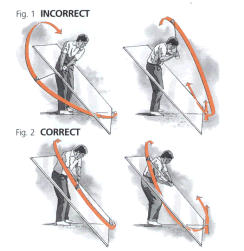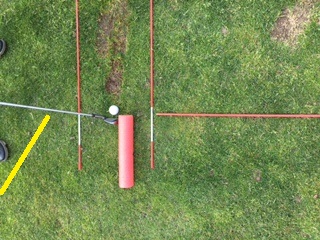Prepare to play your best golf by doing something now!
Lesson Comments: What Students Have To Say
Sponsors: Plum Creek Driving Range
Batavia Country Club
Chestnut Hill Country Club
Click here: INDOOR GOLF LESSONS for details on how to improve your game over the winter.
Plum Creek Driving Range, Batavia, NY, Open All Year
Simulator Course Play Specials: BataviaGolf.com Call 585-993-0930 or Email Mark to reserve simulator time!
Buy Gift Certificates for Lessons Sample Gift Certificate
Golf lessons - Outdoor and Indoor - are available at Plum Creek, please call me at 716 474 3005, email me at ttucker@rochester.rr.com, or visit my website at http://www.tomtuckergolf.com/lessonrates.html for details.
Subscribe - http://www.tomtuckergolf.com/signup.html If you like this newsletter, please do me a favor and forward it to your friends so that they may subscribe, thanks!
The Unsubscribe link is at the bottom of this newsletter.
Tom's Featured Tip: 3 Ways To Fix Your "Over The Top" Slice
For simplicity, all advice on actual swings or drills is provided from a right handed perspective.
I would say that the vast majority of the golfers that I instruct have a slice ball flight. That's one that curves to the right (right handers) or to the left (left handers).
The problem most often stems from a downswing path that attacks the ball from outside of the target line to inside the target line on the downswing.
It's commonly called an outside in or over the top swing path. It's also referred to as casting.

Figure 1 Outside To Inside - Figure 2 Inside To Inside
It not only causes either a slice (common) or a dead pull (less common), but it's also a huge power leak.
Attacking the ball from the inside on your downswing, on the other hand, can produce a nice draw and provides more swing speed due to the angular momentum gained from that path direction.
The first way to change your downswing is to be aware that you have the problem. If you are a chronic slicer, I'm pretty sure that you have the problem.
Here are three ways to help you develop a good downswing path. The the first tip is a thought pattern that I try to infuse in all of my students that you probably haven't heard of before. It's the simplest concept that I've ever thought of for developing a good downswing path.
- An outside to inside path is almost always executed on a very steep angle.
This downward strike angle is caused by an intention to hit at the golf ball, not swing at the target. So here's the cure:
Think "swing towards the target" not "hit the ball" on your downswing. Obviously your club needs to collide with the ball, but if you are thinking "swing towards the target" primarily instead of "hit the ball", it establishes the right frame of mind to execute your downswing on the correct path. When you are thinking correctly, the outside in path actually feels wrong.
-
Path Duplication. Keep in mind that your left arm controls your swingpath, and your right hand controls the clubface.
Try to repeat your left arm takeaway and backswing angle with your left arm downswing angle.
Here's a practice constraint drill setup you can use to help you groove an inside downswing attack path to the ball:

The pool noodle will let you know if you are
coming over the top on your downswing.
- Slide your hips laterally (1st) as well as rotationally (2nd) to initiate your downswing sequence. Those of you that are very observant may have noticed that in the first image above, that the downswing angle doesn't look like it duplicated the backswing angle. That's because the lateral hip slide actually drops the angle a little more to increase the inside attack angle. Don't consciously try to do that. As long as you are trying to duplicate the path and you initiate the downswing sequence with a lateral hip bump and turn, the attack angle will be from the inside. Make sure that the lateral move precedes your hip rotation slightly, or you'll be back to an outside in path.
There are volumes of information written about angles and swing planes. But know that if you understand your own swing circle concept and do the three things listed above, you'll develop a good golf swing.
Comments: ttucker@rochester.rr.com
Love your practice, own your swing, own your health,
Tom
Golf Lessons
I conduct lessons at The Plum Creek Driving Range & Practice Facility
there's a link for Plum Creek info here: http://www.tomtuckergolf.com/
Lessons are available for all ages and skill levels, please contact
me - Tom Tucker - at (716) 474 3005 or email me at ttucker@rochester.rr.com
for more information.
Outdoor Lessons Details and Rates:
http://www.tomtuckergolf.com/lessonrates.html
Indoor Lessons Details and Rates:
http://www.tomtuckergolf.com/indoor.html
Testimonials:
http://www.tomtuckergolf.com/testimonials.html
Sponsors
Plum Creek Driving Range and Simulator Outdoor range and play indoor golf on any of our 40 Simulator Courses. Call 585-993-0930 or email Mark at plumcreek4@rochester.rr.com to reserve time for simulator play or practice!
Batavia Country Club (585) 343-7600 www.bataviacc.com
Great rates, the best greens in WNY. Golf Digest Four Star rating for public courses to play in New York State.
Tee times online or by phone in season.
Chestnut Hill Country Club (585)-547-3613 www.chestnuthillgolf.com
THE WESTERN NEW YORK LEADER IN GOLF OUTINGS!
Only minutes from Buffalo, open to the public.
Tee times online or by phone in season.
All the best,
Tom Tucker
Teaching Pro, Plum Creek Driving Range & Practice Facility
WGTF ' "Top 100 Golf Teacher"
USGTF Class "A" Teaching Professional
IGPA Certified Golf Psychology Coach
Cell: (716) 474-3005
Email: ttucker@rochester.rr.com
http://www.TomTuckerGolf.com
"There are no substitutes in the quest for perfection!"
~ Ben Hogan